|
|
 |
|
Calanoida ( Order ) |
|
|
|
Clausocalanoidea ( Superfamily ) |
|
|
|
Euchaetidae ( Family ) |
|
|
|
Paraeuchaeta ( Genus ) |
|
|
| |
Paraeuchaeta bisinuata (Sars, 1907) (F,M) | |
| | | | | | | Syn.: | Euchaeta bisinuata Sars, 1907 a (p.12); Farran, 1908 b (p.45, figs.F); Vervoort, 1963 b (p.175, Rem.); Owre & Foyo, 1967 (p.53, figs.F,M); Grice & Hulsemann, 1967 (p.15); 1968 (tab.2); Park, 1970 (p.476); 1975 c (p.9, figs.F,M); Deevey & Brooks, 1977 (p.256, tab.2, Station "S"); Park, 1978 (p.244, figs.F); Suarez & al., 1990 (tab.2); Suarez & Gasca, 1991 (tab.2); Suarez, 1992 (App.1); Mauchline, 1992 a (p.2, 3); 1999 (n°182, p.8, figs.F,M);
Euchaete bisinuata : With, 1915 (p.183, figs.F,M);
Pareuchaeta bisinuata : Sars, 1925 (p.123, figs.F,M); Rose, 1929 (p.25); 1933 a (p.123, figs.F,M); Jespersen, 1934 (p.82); Lysholm & al., 1945 (p.24); C.B. Wilson, 1950 (p.276); Tanaka, 1958 (p.343, figs.F); Paiva, 1963 (p.43); Tanaka & Omori, 1968 (p.230, figs.F); Yamanaka, 1976 (p.170); Vaissière & Séguin, 1980 (p.23, tab.1); Kovalev & Shmeleva, 1982 (p.83); Vives, 1982 (p.291); Guangshan & Honglin, 1984 (p.118, tab.); Lozano Soldevilla & al., 1988 (p.58); Mauchline, 1998 (tab.42); Holmes, 2001 (p.52) | | | | Ref.: | | | A. Scott, 1909 (p.70, figs.F); Sewell, 1929 (p.133, 154, 158); Jespersen, 1934 (p.82); Sewell, 1947 (p.120, 125); Bradford & al., 1983 (p.31, figs.F,M, Rem.); Park, 1994 (p.322); 1995 (p.91, Redescr.F,M, figs.F,M); Chihara & Murano, 1997 (p.799, Pl.105,112: F,M); Bradford-Grieve & al., 1999 (p.880, 926, figs.F,M); Vives & Shmeleva, 2007 (p.659, figs.F,M, Rem.) | 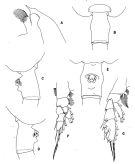 issued from : T. Park in Antarctic Res. Ser. Washington, 1978, 27. [p.245, Fig.94]. As Euchaeta bisinuata. Female: forehead (lateral); B, C, D, E, distal end of metasome and genital segment (dorsal, left side, right side, and ventral); F, P1; G, P2. P1-2: legs (anterior).
|
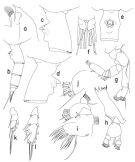 issued from : T. Park in Bull. Scripps Inst. Oceanogr. Univ. California, San Diego, 1995, 29. [p.196, Fig.86]. Female: a, forehead (left side); b, urosome (left); c, d, e, genital somite (left, right, ventral, respectively); f, caudal rami (ventral); g, A2; h, Md; i, Mx1 (first inner lobe separated), posterior; j, basis and endopod of Mx1 fom different specimen showing variation in setation; k, exopod of P1 (anterior); l, exopod of P2 (anterior). Nota: Appendicular caudal setae smoothly curved. Anterior lobe of genital flange (Fig.86 c) produced into a toothlike process. A2: Basis with a single seta and marginal seta of 2nd exopodal segment very small. Md: 1st endopodal segment without setae. Mx1: 1st inner lobe with 1 anterior, 9 marginal, and 2 posterior setae; basis with 3 setae. 1st exopodal segment of P1 with well-developed outer spine. Genital somite in dorsal view, symmetrical, with conspicuous swelling at middle. Laterally, genital prominence broad but relatinely low; each genital flange divided into an anterior and a posterior lobe; anterior lobe toothlike, with a blunt tip; posterior lobe lower but wider that anterior one; two genital flanges, however, are not symmetrical, the right anterior lobe being much larger and the right posterior lobe being wider than the corresponding lobes of the left side. Posterior edge of genital field appearing like a large lobe, together with 2 lobes of genital flange, giving genital prominence a trilobed structure. Ventrally, genital field appears symmetrical (Fig.86 e)/
|
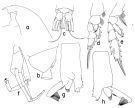 issued from : T. Park in Bull. Scripps Inst. Oceanogr. Univ. California, San Diego, 1995, 29. [p.197, Fig.87]. Male: a, forehead (left side); b, last pedigerous and genital somites (left); c, caudal rami (ventral); d, P1 (anterior); e, P2 (anterior); f, P5 (viewed from right); g, h, distal exopodal segments of left 5th leg (medial, lateral, respectively). Nota: A1 extending beyond distal end of prosome by its last 3 segments and reaching distal end of 2nd urosomal somite. All cephalosomal appendages similar to those of P. malayensis.
|
 issued from : O. Tanaka in Publs Seto Mar. Biol. Lab., 1958, VI (3). [p.313, Fig.69]. As Pareuchaeta bisinuata. Female: a, habitus (dorsal); b, forehead (lateral right side); c, last thoracic segment and genital somite (lateral left side); d, exopod of P1; e, exopod of P2. Nota: The urosome segments and furca are in the proportional lengths as 36:25:21:2:16 = 100. A1extends about to the end of the last thoracic segment.
|
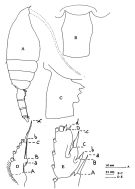 issued from : J.M. Bradford, L. Haakonssen & J.B. Jillett in Mem. N.Z. Oceanogr. Inst., 1983, 90. [p.32, Fig.13]. Female: A, habitus (lateral right side); B, genital segment (dorsal); C, idem (lateral right side); D, exopod of P1; E, exopod segment 3 of P2. Nota: - P1 exopod: Aa = 2/3 AB; Bb ± BC; Cc > BC. - P2 exopod: Aa = AB + 1/2 Bb; Bb = 1/2 BC; Cc < CD. (see code of lengths outer spine in the Genus' figure of Paraeuchaeta, or in Paraeuchaeta sp. A). The female from the south-west Pacific has longer spines on P1.
|
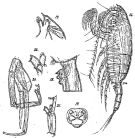 Issued from : G.O. Sars in Résult. Camp. Scient. Prince Albert I, 69, pls.1-127 (1924). [Pl.XXXIII, figs.16-22]. As Pareuchaeta bisinuata. Female: 16, habitus (lateral left side); 17, forehead (lateral); 18, genital somite (lateral left side); 19, genital complex (ventral). Male: 20, P5; 21, distal segments of left P5 (enlarged); 22, idem (enlarged).
|
 issued from : A. Scott in Siboga-Expedition, 1909, XIX a. [Plate XVI, Figs.10-17]. Female (from Banda Sea): 10, habitus (dorsal); 11, forehead (lateral); 12, last thoracic and genital segments (left side); 13, A1; 14, part of one of the distal hairs of Mxp; 15, P1; 16, P2; 17, part of terminal spine (exopodite of P3).
|
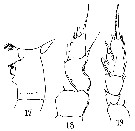 issued from : G.P. Farran in Fish. Ire. Sci. Invest., 1906, II [1908]. [Pl. III, Figs.17-19]. As Euchaeta bisinuata. Female (from W Ireland): 17, genital segment (lateral); 18, exopod of P1; 19, exopod of P2. Nota: Sars descibes the genital protuberance as being divided into 3 lobes, of which the most anterior is double. Farran has figured the arrangement as shown in all the specimens examined, in which both of the anterior lobules are paired.
|
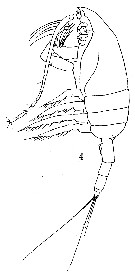 issued from : G.P. Farran in Fish. Ire. Sci. Invest., 1906, II [1908]. [Pl. IV, Fig.4]. As Euchaeta bisinuata. Female: 4, habitus (lateral).
|
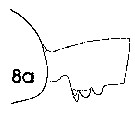 issued from : J. Mauchline in ICES Ident. Leafl. Plankton, 1999, N°182. [p.3, Fig.2: 8a]. As Euchaeta bisinuata. Female (Northeast Atlantic): 8a, genital double-somite (left side).
|
 issued from : J. Mauchline in ICES Ident. Leafl. Plankton, 1999, N°182. [p.4, Fig.3: 8b]. As Euchaeta bisinuata. Male (Northeast Atlantic): 8b, terminal two segments, exopodal segments of left P5.
|
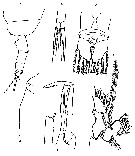 issued from : C. With in The Danish Ingolf-Expedition, 1915, III (4). [p.184, Text-Fig.54]. As Euchaeta bisinuata. Female (from 61°30'N, 17°08'W): a, last thoracic segment and urosome; b, anal segment and caudal rami; c, same (magnified); d, outer margin of the basal segment of Mx2; e, P1. Male: f, P5 (anterior view).
|
 issued from : C. With in The Danish Ingolf-Expedition, 1915, III (4). [Pl. VI, 11 d-e]. As Euchaete bisinuata. Male: 2nd and 3rd segments of left P5.
|
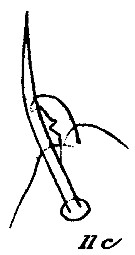 issued from : C. With in The Danish Ingolf-Expedition, 1915, III (4). [Pl. VI, Fig.11, c]. As Euchaete bisinuata. Male: c, Mxp (hook-shaped seta of the lobe 4).
|
 issued from : C. With in The Danish Ingolf-Expedition, 1915, III (4). [Pl. VI, Fig.11, a-b]. As Euchaete bisinuata. Female: a, labrum (oral view); b, lamina labialis.
|
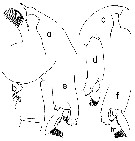 issued from : T. Park in Smiths. Contr. Zool., 1975, 196. [p.10, Fig.8]. As Euchaeta bisinuata. Female (G. of Mexico): a, forehead (lateral); b, genital segment (lateral). Male: c, forehead (lateral); d, exopodite of left P5 (anterior); e- f, same (lateral). ht = haired tubercle. Nota: One of the more common bathypelagic euchaetid species throughout the tropical, subtropical, and temperate zones of the World Ocean. In the Gulf of Mexico and western Caribbean Sea, it was found to be the most common euchaetid species in the bathypelagial zone, most of them from a depth range below 1000 m.
|
 issued from : H.B. Owre & M. Foyo in Fauna Caribaea, 1967, 1, Crustacea, 1: Copepoda. [p.53, Fig.309]. As Euchaeta bisinuata. Female (from Florida Current): 309, habitus (dorsal).
|
 issued from : H.B. Owre & M. Foyo in Fauna Caribaea, 1967, 1, Crustacea, 1: Copepoda. [p.53, Figs.313-314]. Female: 313, Mx1; 314, outer lobe of Mx1.
| | | | | Compl. Ref.: | | | Sewell, 1948 (p.331, 501, 521); Grice, 1963 a (p.495); Suarez-Morales Gasca, 1998 a (p.109); Hsiao & al., 2004 (p.326, tab.1); Park & Ferrari, 2009 (p.143, fig.1, biogeography, Rem. p.166); Mazzocchi & Di Capua, 2010 (p.425); El Arraj & al., 2017 (p.272, table 2); Belmonte, 2018 (p.273, Table I: Italian zones) | | | | NZ: | 15 | | |
|
Distribution map of Paraeuchaeta bisinuata by geographical zones
|
| | | | | | | | | | | | | Loc: | | | G. of Guinea, Dakar, Cape Verde Is., off Morocco-Mauritania, Canary Is., off Madeira, Azores, SW Atlant., Caribbean, Caribbean Sea, G. of Mexico, Florida, off Bermuda: Station "S" (32°10'N, 64°30'W), S Davis Strait, S Iceland, off Rockall Is., Faroe Is., Norwegian Sea, off W Ireland, Portugal, Bay of Biscay, W Medit. (Ligurian Sea, Tyrrhenian Sea), Arabian Sea, Laccadive Is., Indian, off E Sri Lanka, Bay of Bengal, Indonesia-Malaysia, Philippines, China Seas (South China Sea), E Taiwan, Japan (Sagami Bay), Aleutian Is., Pacif. (W equatorial), Tasman Sea, SE Pacif. (off Juan Fernandez Is.), N Chile | | | | N: | 42 | | | | Lg.: | | | (1) F: 5,1; (3) F: 5,7-5,3; M: 5,2-4,7; (5) F: 5; (7) F: 5,62; M: 4,8; (14) F: 5,4-5; M: 4,4-4,25; (19) F: 5,17-5,58; M: 4,48-4,75; (20) F: 5,83-5,5; (63) F: 5,97-5,15; (73) F: 5,66; (99) F: 5,5; {F: 5,00-5,97; M: 4,25-5,20}
The mean female size is 5.432 mm (n = 15; SD = 0.3033), and the mean male size is 4.654 mm (n = 7; SD = 0.3133). The size ratio (male : female) is 0.861 (n = 4; SD = 0.0284), or ± 86 %. | | | | Rem.: | bathypelagic. Sargasso Sea: 500-2000 m (Deevey & Brooks, 1977, station "S");
According to Park (1975 c, p.10) this is one of the more common euchaetid species in the bathyal zone of the Gulf of Mexico and western Caribbean Sea.
For Park (1995, p.92) this form is very close to the antarctica species Group, but distinct in the following respects: In Md, the small additional seta on the basis and appendicular seta on the 2nd endopodal segment are absent; in Mx1, 1st inner lobe with 2 posterior setae (instead of 3), and 2nd inner lobe with a single seta (instead of 2); genital operculum without a conspicuous central projection; the serrated lamella of the male left P5 is short and bordered with a small number of large teeth, and the hairy tubercle is rounded, without a distal spiniform process.
In the samples, Park (1995) found widely in the low and midlatitudes of all three great oceans; the northernmost locations where 53°N in the Atlantic, 35°N in the eastern and western Pacific, 31°N in the central Pacific, and 17°N in the Bay of Bengal; the southernmost locations were 32°S in the Atlantic, 40°S in the central Pacific, 49°S in the Tasman Sea, and 25°S in the western Indian Ocean. | | | Last update : 24/10/2022 | |
|
|
 Any use of this site for a publication will be mentioned with the following reference : Any use of this site for a publication will be mentioned with the following reference :
Razouls C., Desreumaux N., Kouwenberg J. and de Bovée F., 2005-2026. - Biodiversity of Marine Planktonic Copepods (morphology, geographical distribution and biological data). Sorbonne University, CNRS. Available at http://copepodes.obs-banyuls.fr/en [Accessed January 08, 2026] © copyright 2005-2026 Sorbonne University, CNRS
|
|
 |
 |




















